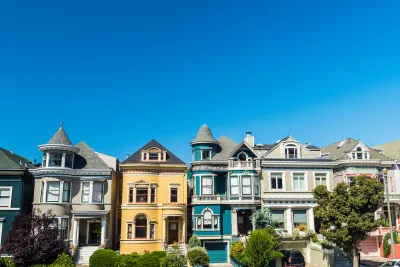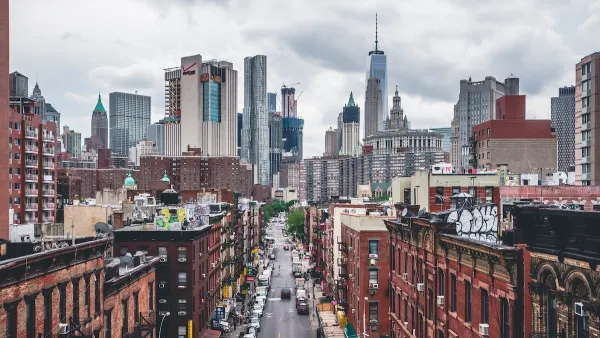A “Planners’ Pledge” created by some of the leading authorities on planning sets forth a bold urbanist agenda- even if not every idea in the pledge is equally useful in all cities.

When I attended the Congress for New Urbanism (CNU) conference last year, Jeff Speck spoke eloquently about the idea of a “Planners’ Pledge.” Planners could sign the pledge to commit to more environmentally friendly, walkable development.
The Pledge is now public, and it is signed by some of the most eminent authorities on urban policy, including people who I have known for decades such as Emily Talen and Scott Bernstein, as well as newer voices like Peter Norton, Diana Lind, and Angie Schmitt. Naturally, the Pledge has much to recommend it — but also includes some ideas I am not so enthusiastic about.
The Pledge begins with an explanatory section, pointing out that “planners have contributed to the creation of a landscape that separates us ruthlessly both from different activities … such that we are inordinately connected to our automobiles and less connected to one another.” The Pledge then contains a set of “whereas” clauses elaborating on this idea, thirty concepts that planners should encourage, and fifteen that planners should discourage.
Most of the “encourage/discourage” policies are exactly what I would have expected from New Urbanists. For example, the Pledge endorses encouraging more housing in walkable areas and dense development near public transit, while suggesting that highway construction and car-dependent places should be discouraged. Although I agree with these goals, I was especially heartened by the Pledge’s emphasis on street design, an area that might have gotten less coverage before the growth of car crash deaths in the 2010s and 2020s. Rather than merely throwing on a few platitudes about Vision Zero, the Pledge urges that roads be limited to a design speed “no higher than the desired vehicle speed” and sizing “firefighting equipment to fit community streets and not vice versa” (in other words, narrower streets). More broadly, the Pledge urges planners to discourage the creation of new streets that do not “safely welcome pedestrians and cyclists” and to oppose the use of environmental review that stalls pedestrian and cyclist facilities.
On the other hand, the Pledge does have a few ideas that seem dated to me. The Pledge contains too many platitudes about community engagement for my taste, stating that planners should encourage a “fully inclusive community planning process” and discourage the “creation of any neighborhood plan without first engaging the local community.” It seems to me that this emphasis on community planning may have made more sense a few decades ago when housing supply and housing costs were not nationwide problems.
But today, it seems clear to me that the interests of an individual neighborhood (let alone the interests of the tiny fraction of neighborhood residents who attend planning-related meetings) are often not the interests of the broader city, region, or planet. It may be rational for each neighborhood to want to preserve the status quo. For example, even if planners inform a wealthy neighborhood’s residents that new housing might not lead to an influx of poor people or traffic, the residents might understandably be afraid of taking a chance. But if every neighborhood stops or slows down the healthier changes endorsed by the Pledge, no housing gets built, and people priced out of existing housing may be forced to move to automobile-dependent suburbia.
The Pledge also encourages planners to support inclusionary zoning. Inclusionary zoning (requiring developers to set aside a certain percentage of apartments for unprofitable, lower-income housing) makes sense if you think developers can afford to build unprofitable apartments and still make a healthy profit. But this idea seems less plausible now than it did a couple of decades ago: rising land costs, rising construction costs, rising taxes, and rising insurance costs have made all forms of development less profitable in many places. It follows that burdening developers with an additional tax (in the form of unprofitable apartments) seems likely to reduce housing supply.*
The Pledge comes down strongly on the side of historic preservation, urging planners to discourage the “destruction of any significant sidewalk-facing building façade more than 100 years old.” This restriction seems to me quite sensible in newer cities such as Orlando, where such buildings are either rare or concentrated in a small number of historic neighborhoods. But in older cities like mine, there are many, many such buildings, so preserving of all of them would make the creation of new homes and apartments far more difficult than in Orlando. Some of the older cities with the most pre-1925 buildings are also the cities with the best public transit (such as New York). So freezing older buildings in place seems to me a bit inconsistent with the Pledge’s goal of transit-oriented development.
On balance, I certainly find at least 80 percent of the Pledge appealing. But I suspect that if it was written by planners younger than myself, or maybe just planners with more market-oriented views, it would be a bit different.
*For a much more detailed discussion I recommend this post.

National Parks Layoffs Will Cause Communities to Lose Billions
Thousands of essential park workers were laid off this week, just before the busy spring break season.

Retro-silient?: America’s First “Eco-burb,” The Woodlands Turns 50
A master-planned community north of Houston offers lessons on green infrastructure and resilient design, but falls short of its founder’s lofty affordability and walkability goals.

Delivering for America Plan Will Downgrade Mail Service in at Least 49.5 Percent of Zip Codes
Republican and Democrat lawmakers criticize the plan for its disproportionate negative impact on rural communities.

Test News Post 1
This is a summary

Test News Headline 46
Test for the image on the front page.

Balancing Bombs and Butterflies: How the National Guard Protects a Rare Species
The National Guard at Fort Indiantown Gap uses GIS technology and land management strategies to balance military training with conservation efforts, ensuring the survival of the rare eastern regal fritillary butterfly.
Urban Design for Planners 1: Software Tools
This six-course series explores essential urban design concepts using open source software and equips planners with the tools they need to participate fully in the urban design process.
Planning for Universal Design
Learn the tools for implementing Universal Design in planning regulations.
EMC Planning Group, Inc.
Planetizen
Planetizen
Mpact (formerly Rail~Volution)
Great Falls Development Authority, Inc.
HUDs Office of Policy Development and Research
NYU Wagner Graduate School of Public Service






























